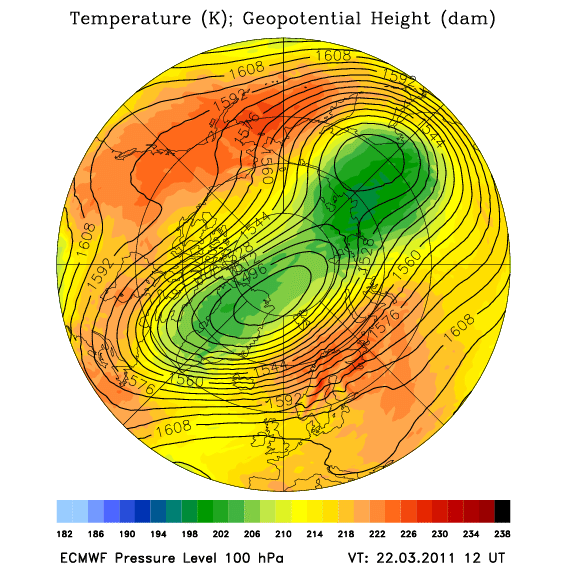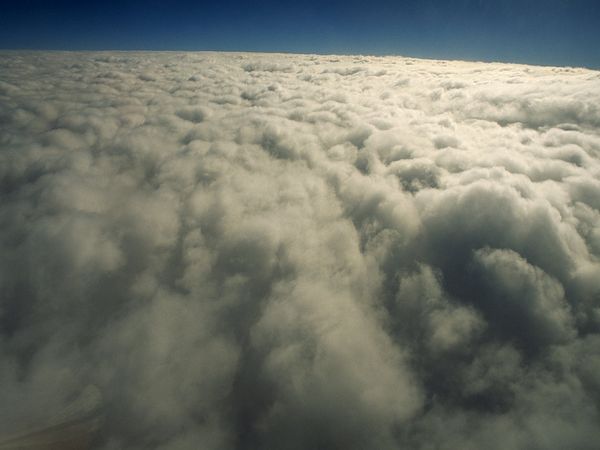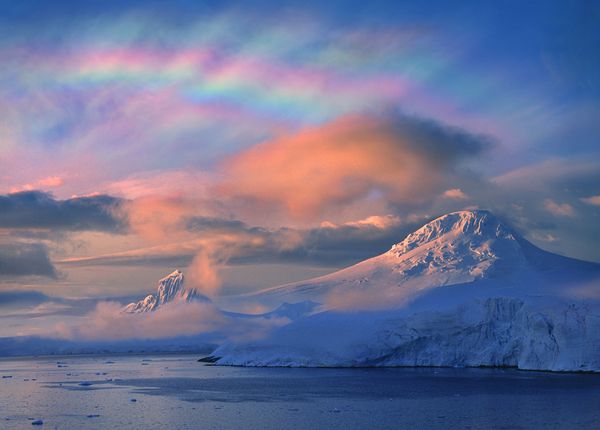First North Pole Ozone Hole Forming?

We reported earlier about ozone depletion in article Arctic May Face Record Loss of Ozone This Spring. Researchers from the Alfred Wegener Institute for Polar and Marine Research in Bremerhaven, Germany made new research where they saying that continuing high-altitude freeze over the Arctic may have already reduced ozone to half its normal concentrations—and an end is not in sight. Preliminary data from 30 ozone-monitoring stations throughout the Arctic show the degree of ozone loss was larger this winter than ever before.
Spawned by strangely cold temperatures, “beautiful” clouds helped strip the Arctic atmosphere of most of its protective ozone this winter. The resulting zone of low-ozone air could drift as far south as New York, according to experts who warn of increased skin-cancer risk. The stratosphere’s global blanket of ozone—about 12 miles (20 kilometers) above Earth—blocks most of the sun’s high-frequency ultraviolet (UV) rays from hitting Earth’s surface, largely preventing sunburn and skin cancer.
Scientists from National Center for Atmospheric Research (NCAR) do not know at the moment how large the ozone hole in the Arctic will grow, because the thinning of the ozone layer is happening right now. Full confirmation may require computer simulations and satellite measurements, which study would be very useful to provide an independent view of the ozone loss this year. Before spring is out, “we may even get the first Arctic ozone hole … which would be a dramatic development—one which would make it into coming history books.
An ozone hole is an area of the ozone layer that is seasonally depleted of the protective gas—such as the well-known hole over Antarctica. You can read more about ozone depletion here.

In the 1980s scientists realized chlorofluorocarbons (CFCs) and other ozone-depleting chemicals—then widely used in aerosol hairsprays and refrigerants, for example—were degrading the ozone layer. The 1987 Montreal Protocol initiated a global phase-out of CFCs, replacing them with alternatives that don’t destroy ozone. However, CFCs can persist for decades in the stratosphere—the Antarctic ozone hole is still there, though it’s expected to grow smaller in coming decades. Once in the upper atmosphere, CFCs break down into chlorine atoms, which, when activated by sunlight, destroy ozone molecules.
Cold temperatures speed up this process through polar stratospheric clouds, “beautiful” and still little understood formations that occur once stratospheric temperatures drop to at least -78 degrees Celsius (-108 degrees Fahrenheit) . The clouds provide “reservoirs” for inactivated byproducts of chlorine. On the surface of the cloud, these byproducts react with each other and release “aggressive” chlorine atoms that attack ozone molecules.
The whole process stops as soon as it gets warmer and the so-called Arctic polar vortex breaks up. At about 6 million square miles (15 million square kilometers), or 40 times the size of Germany, the Arctic polar vortex is a frigid air mass that circles the North Pole in winter. As greenhouse gases trap heat in the lower levels of the atmosphere, the higher levels tend to cool. There may be many ways in which greenhouse gases influence high-altitude temperatures.
Any spike in UV radiation can impact both the Arctic ecosystem and human health. For instance, more sunlight can slow the growth of certain species of ocean algae that provide food for larger organisms—and whose absence can have reverberations up the food chain. Ozone-depleted air can catch a ride south to more highly populated areas with the Arctic polar vortex. Low-ozone air is often pushed southward to 40 or 45 degrees latitude by natural atmospheric disturbances. A low-ozone air mass’s southern “excursions” can take it as far as northern Italy in Europe or New York or San Francisco in the United States.
The rapidly shifting vortex might last into April, when people are starting to spend more time outside. A good message for people



Commenting rules and guidelines
We value the thoughts and opinions of our readers and welcome healthy discussions on our website. In order to maintain a respectful and positive community, we ask that all commenters follow these rules:
We reserve the right to remove any comments that violate these rules. By commenting on our website, you agree to abide by these guidelines. Thank you for helping to create a positive and welcoming environment for all.